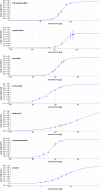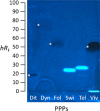Non-target estrogenic screening of 60 pesticides, six plant protection products, and tomato, grape, and wine samples by planar chromatography combined with the planar yeast estrogen screen bioassay
- PMID: 36877263
- PMCID: PMC10766744
- DOI: 10.1007/s00216-023-04605-x
Non-target estrogenic screening of 60 pesticides, six plant protection products, and tomato, grape, and wine samples by planar chromatography combined with the planar yeast estrogen screen bioassay
Abstract
For non-target residue analysis of xenoestrogens in food, sophisticated chromatographic-mass spectrometric techniques lack in biological effect detection. Various in vitro assays providing sum values encounter problems when opposing signals are present in a complex sample. Due to physicochemical signal reduction, cytotoxic or antagonistic effect responses, the resulting sum value is falsified. Instead, the demonstrated non-target estrogenic screening with an integrated planar chromatographic separation differentiated opposing signals, detected and prioritized important estrogenic compounds, and directly assigned tentatively the responsible compounds. Sixty pesticides were investigated, ten of which showed estrogenic effects. Exemplarily, half-maximal effective concentrations and 17β-estradiol equivalents were determined. Estrogenic pesticide responses were confirmed in six tested plant protection products. In food, such as tomato, grape, and wine, several compounds with an estrogenic effect were detected. It showed that rinsing with water was not sufficient to remove selected residues and illustrated that, though not usually performed for tomatoes, peeling would be more appropriate. Though not in the focus, reaction or breakdown products that are estrogenic were detected, underlining the great potential of non-target planar chromatographic bioassay screening for food safety and food control.
Keywords: Bioautography; Endocrine-disrupting compounds; Food safety; Planar yeast estrogen screen; Residue analysis.
© 2023. The Author(s).
Conflict of interest statement
The authors declare no competing interests.
Figures







Similar articles
-
Investigation of the estrogenic potential of 15 rosé, white and red wines via effect-directed ten-dimensional hyphenation.J Chromatogr A. 2023 Feb 8;1690:463775. doi: 10.1016/j.chroma.2023.463775. Epub 2023 Jan 6. J Chromatogr A. 2023. PMID: 36641942
-
Unprecedented sensitivity of the planar yeast estrogen screen by using a spray-on technology.J Chromatogr A. 2017 Dec 29;1530:185-191. doi: 10.1016/j.chroma.2017.11.009. Epub 2017 Nov 7. J Chromatogr A. 2017. PMID: 29146425
-
Determination of estrogens and estrogenic activity in wastewater effluent by chemical analysis and the bioluminescent yeast assay.Sci Total Environ. 2007 Jun 1;378(3):343-51. doi: 10.1016/j.scitotenv.2007.02.030. Epub 2007 Apr 11. Sci Total Environ. 2007. PMID: 17428521
-
What level of estrogenic activity determined by in vitro assays in municipal waste waters can be considered as safe?Environ Int. 2014 Mar;64:98-109. doi: 10.1016/j.envint.2013.12.009. Epub 2013 Dec 31. Environ Int. 2014. PMID: 24384232 Review.
-
Mass spectrometry in grape and wine chemistry. Part II: The consumer protection.Mass Spectrom Rev. 2006 Sep-Oct;25(5):741-74. doi: 10.1002/mas.20087. Mass Spectrom Rev. 2006. PMID: 16555227 Review.
Cited by
-
Characterization of the SARS-CoV-2 Genome 3'-Untranslated Region Interactions with Host MicroRNAs.ACS Omega. 2024 Aug 16;9(34):36148-36164. doi: 10.1021/acsomega.4c01050. eCollection 2024 Aug 27. ACS Omega. 2024. PMID: 39220490 Free PMC article.
References
-
- European Parliament and Council of the European Union. Regulation (EC) No 1107/2009 of the European Parliament and of the Council of 21 October 2009 concerning the placing of plant protection products on the market and repealing Council Directives 79/117/EEC and 91/414/EEC; 2009.
-
- European Parliament and Council of the European Union. Regulation (EC) No 396/2005 of the European Parliament and of the Council of 23 February 2005 on maximum residue levels of pesticides in or on food and feed of plant and animal origin and amending Council Directive 91/414/EEC; 2005.
-
- EU pesticides database. https://food.ec.europa.eu/plants/pesticides/eu-pesticides-database_en. Accessed 22 Sep 2022.
MeSH terms
Substances
LinkOut - more resources
Full Text Sources
Medical

